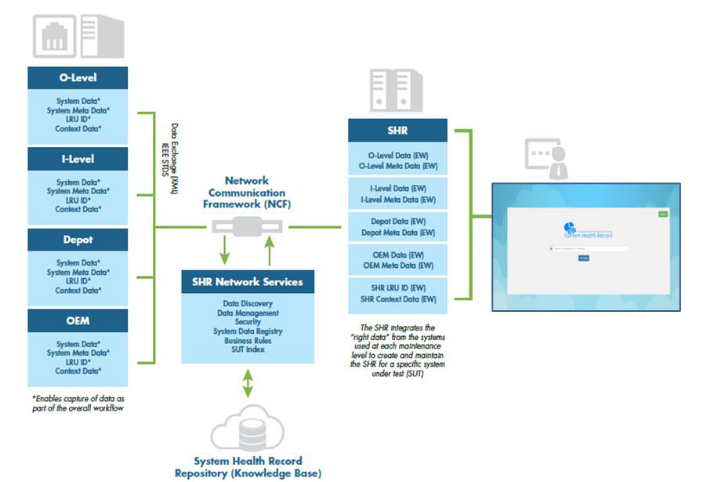System Health Record “SHR©”

- The System Health Record (SHR©) is an electronic record of the system’s state of health (SOH) and maintenance information generated by one or more diagnostic sessions or maintenance events.
- The SHR© integrates the general system information, technician notes, problem description, health parameters, troubleshooting, past maintenance history, repairs, test data and test results.
- The SHR© relates to a single, unique record created and stored in one or more physical systems within a maintenance organization.
- Each maintenance event results in the capture of data to provide a record of the maintenance and testing that has been performed.
- The SHR© enables the efficient collection, transformation and exchange of health state data across levels of maintenance.
System Health Record Compared to Health Care's Electronic Health Record
Why implement SHR? The commercial application of Electronic Health Records transformed healthcare. GSS believes the SHR can do the same by revolutionizing vehicle maintenance.
What GSS did
Created the System Health Record (SHR) which provides the data integration framework for acquiring, integrating, processing, distributing and managing health state data across multiple levels of maintenance. The SHR stores and displays aircraft Built-In-Test data, Automatic Test Equipment (ATE) test result data, and maintenance action data for each Unit Under Test (UUT) within one repository for users to make informed decisions using the UUT’s entire health history across all levels of maintenance.
Benefits
- Enables significant operational benefits by reducing or eliminating time and costs associated with the “hit or miss” trial and error testing and repair methods and the No-Fault-Found (NFF) incidents.
- Delivers higher rates of operational system availability and significant reductions in aircraft operating and support costs by replacing parts accurately and before they fail.
- Easily integrated with existing automated logistics environments by utilizing the data sources that already exist.
- Each maintenance event results in the capture of data to provide a record of the maintenance and testing that has been performed.
- The SHR© enables the efficient collection, transformation and exchange of health state data across levels of maintenance.
What they did
Created the Electronic Health Record (EHR) which shares information privately and securely with the patient’s authorization in an accessible patient portal. This system helps health care quality, prevents medical errors, reduces paperwork, and improves administrative efficiencies and health care quality for health and human services.
Benefits
- Improved financial outcome
- Improved quality of care.
- Improved patient satisfaction
- Saved documentation time
Healthcare providers can make more informed decisions, reduce errors, and ultimately provide better patient care. But their real advantage lies in flexibility. As a practice expands, EMR systems grow right along with it, effortlessly handling more patients and integrating the latest technology to keep it on the cutting edge of healthcare.

